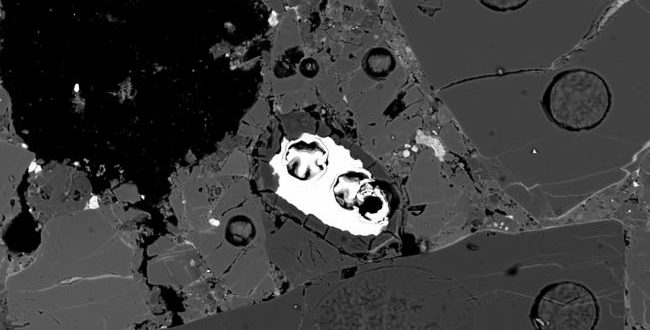Researchers have discovered pieces of opal in a meteorite in Antarctica. The findings are extremely important for related studies on water and its life-forming abilities.
Tiny fragments of opal were spotted in a meteorite EET 83309, which was picked up off the ice in east Antarctica – the second time a meteorite has been found containing the gemstone. (The first was a Martian meteorite, reported in July last year.)
The work was presented by the UK’s Birkbeck College London’s Hilary Downes at the Royal Astronomical Society meeting in Nottingham.
On Earth, opals form when silica in a watery solution becomes wedged in cracks between rocks. Over millions of years, the silica hardens to become the shimmery coloured rock we prize today.
The key here, and what has planetary scientists excited, is opal needs water to form – it can even hold up to 30% water. So a meteorite carrying opal means it came in contact with water millions of years ago.
EET 83309 isn’t a nice, rounded rock. About 4 x 4 x 2.4 centimetres, it’s a conglomerate, a fragment of a meteorite containing lots of smaller fragments of other meteorites. It’s thought it was once part of a parent asteroid that copped plenty of hits from bits of rock floating around the solar system. Some of those rocks embedded themselves into the asteroid.
One or more of these impacts, Downes believes, brought water ice to the asteroid and allowed the opal to form.
“The pieces of opal we have found are either broken fragments or they are replacing other minerals,” she says.
“Our evidence shows that the opal formed before the meteorite was blasted off from the surface of the parent asteroid and sent into space, eventually to land on Earth in Antarctica.”
Given the meteorite landed on water ice, and may have been sitting out in the open for millions of years, could the opal have formed after it landed?
Downes and her colleagues doubt it. Although the opal interacted a little with Antarctic water, there was more “heavy water” (water where one or both hydrogen atoms has been replaced with a slightly heavier deuterium atom) in the opal and meteorite than in Earthly water.
“This is more evidence that meteorites and asteroids can carry large amounts of water ice,” Downes says.
“Although we rightly worry about the consequences of the impact of large asteroids, billions of years ago they may have brought the water to the Earth and helped it become the world teeming with life that we live in today.”
Agencies/Canadajournal
 Canada Journal – News of the World Articles and videos to bring you the biggest Canadian news stories from across the country every day
Canada Journal – News of the World Articles and videos to bring you the biggest Canadian news stories from across the country every day




Whatever.
Still amazes me that they know where these rocks come from and still they can’t give us a real picture of Earth from space.
Oh hey I just found a meteorite from Pluto outside the building LOL, and it’s got concrete on it, there must be advanced life on Pluto LOL .
Gimme a break.